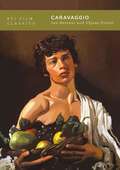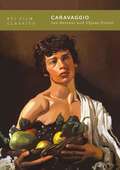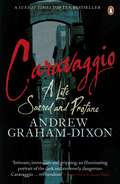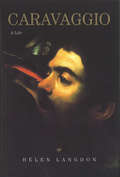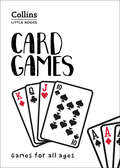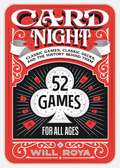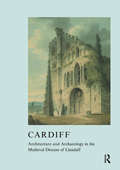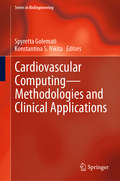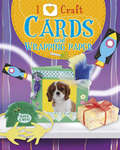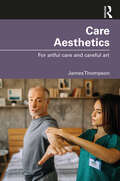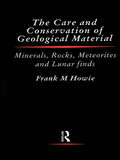- Table View
- List View
Caravaggio (BFI Film Classics)
by Leo Bersani Ulysse DutoitCaravaggio (1986), Derek Jarman's portrait of the Italian Baroque artist, shows the painter at work with models drawn from Rome's homeless and prostitutes, and his relationship with two very different lovers: Ranuccio, played by Sean Bean, and Lena, played by Tilda Swinton. It is probably the closest Derek Jarman came to a mainstream film. And yet the film is a uniquely complex and lucid treatment of Jarman's major concerns: violence, history, homosexuality, and the relation between film and painting. In particular, according to Leo Bersani and Ulysse Dutoit, Caravaggio is unlike Jarman's other work in avoiding a sentimentalising of gay relationships and in making no neat distinction between the exercise and the suffering of violence.Film-making involves a coercive power which, for Bersani and Dutoit, Jarman may, without admitting it to himself, have found deeply seductive. But in Caravaggio this power is renounced, and the result is Jarman's most profound, unsettling and astonishing reflection on sexuality and identity.
Caravaggio (BFI Film Classics)
by Leo Bersani Ulysse DutoitCaravaggio (1986), Derek Jarman's portrait of the Italian Baroque artist, shows the painter at work with models drawn from Rome's homeless and prostitutes, and his relationship with two very different lovers: Ranuccio, played by Sean Bean, and Lena, played by Tilda Swinton. It is probably the closest Derek Jarman came to a mainstream film. And yet the film is a uniquely complex and lucid treatment of Jarman's major concerns: violence, history, homosexuality, and the relation between film and painting. In particular, according to Leo Bersani and Ulysse Dutoit, Caravaggio is unlike Jarman's other work in avoiding a sentimentalising of gay relationships and in making no neat distinction between the exercise and the suffering of violence.Film-making involves a coercive power which, for Bersani and Dutoit, Jarman may, without admitting it to himself, have found deeply seductive. But in Caravaggio this power is renounced, and the result is Jarman's most profound, unsettling and astonishing reflection on sexuality and identity.
Caravaggio: A Life Sacred and Profane
by Andrew Graham DixonMichelangelo Merisi da Caravaggio lived the darkest and most dangerous life of any of the great painters. The worlds of Milan, Rome and Naples through which Caravaggio moved and which Andrew Graham-Dixon describes brilliantly in this book, are those of cardinals and whores, prayer and violence. On the streets surrounding the churches and palaces, brawls and swordfights were regular occurrences. In the course of this desperate life Caravaggio created the most dramatic paintings of his age, using ordinary men and women - often prostitutes and the very poor - to model for his depictions of classic religious scenes. Andrew Graham-Dixon's exceptionally illuminating readings of Caravaggio'spictures, which are the heart of the book, show very clearly how he created their drama, immediacy and humanity, and how completely he departed from the conventions of his time.
Caravaggio
by Howard HibbardCaravaggio was one of the most important Italian painters of the 17th century. He was, in fact, the wellspring of Baroque painting. In Hibbard's words, Caravaggio's paintings "speak to us more personally and more poignantly than any others of the time". In this study, Howard Hibbard evaluates the work of Caravaggio: notorious as a painter-assassin, hailed by many as an original interpreter of the scriptures, a man whose exploration of nature has been likened to that of Galileo.
Caravaggio (Icon Editions Ser.)
by Howard HibbardCaravaggio was one of the most important Italian painters of the 17th century. He was, in fact, the wellspring of Baroque painting. In Hibbard's words, Caravaggio's paintings "speak to us more personally and more poignantly than any others of the time". In this study, Howard Hibbard evaluates the work of Caravaggio: notorious as a painter-assassin, hailed by many as an original interpreter of the scriptures, a man whose exploration of nature has been likened to that of Galileo.
Caravaggio: A Life (Icon Editions Series)
by Helen LangdonOf all Italian painters, Caravaggio (c. 1565-1609) speaks most intensely to the modern world. His early works suggest a fascination with his own youth and sexuality and the trancience of love and beauty his later religious art speaks of violence, passion, solitude and death. Ugly, almost brutal-looking, Caravaggio was constantly embroiled in fights and entangled with the law; the prototype anti-social artist, he moved between the worlds of powerful patrons and the street life of boys and prostitutes. Helen Langdon uncovers his progress from childhood in plague-ridden Milan to wild success in Rome, and eventual exile and persecution in the South, and sets his work against the political, intellectual and spiritual movements of the day. Fully illustrated, her dramatic portrait shows Carravigio's life to be as sensational and enigmatic as his powerful and enduring art.
Carbon: A Field Manual for Building Designers
by Matti Kuittinen Alan Organschi Andrew RuffA comprehensive approach to design that integrates sustainable principles and design strategies for decarbonized construction Representing an international collaboration between academics and architects in the United States and Europe, Carbon: A Field Manual for Designers and Builders offers professionals in the field an approach to sustainable design that embraces building science principles, life-cycle analysis, and design strategies in carbon neutral construction. The book also contains background information on carbon in construction materials and in the building design process. This book is filled with illustrative diagrams and drawings that help evaluate the potential impact of design decisions for creating carbon emissions. Written by and for designers and builders, the book includes a compelling pair of case studies that explore carbon-reducing strategies, suggests steps for assessing a building's carbon footprint, and reviews carbon storages and circulation of materials. The guidelines detailed in the book can be adopted, replicated, and deployed to reduce carbon emissions and create more sustainable buildings. This important book: Offers an effective approach to sustainable design in construction Integrates building science principles, life-cycle analysis, and design strategies in carbon neutral construction Describes a methodology for quantifying the flow of carbon in the built environment Provides an analysis of carbon-reducing strategies based on a case study of a building designed by the authors Written for practicing professionals in architecture and construction, Carbon: A Field Guide for Designers and Builders is a must-have resource for professionals who are dedicated to creating sustainable projects.
Carbon: A Field Manual for Building Designers
by Matti Kuittinen Alan Organschi Andrew RuffA comprehensive approach to design that integrates sustainable principles and design strategies for decarbonized construction Representing an international collaboration between academics and architects in the United States and Europe, Carbon: A Field Manual for Designers and Builders offers professionals in the field an approach to sustainable design that embraces building science principles, life-cycle analysis, and design strategies in carbon neutral construction. The book also contains background information on carbon in construction materials and in the building design process. This book is filled with illustrative diagrams and drawings that help evaluate the potential impact of design decisions for creating carbon emissions. Written by and for designers and builders, the book includes a compelling pair of case studies that explore carbon-reducing strategies, suggests steps for assessing a building's carbon footprint, and reviews carbon storages and circulation of materials. The guidelines detailed in the book can be adopted, replicated, and deployed to reduce carbon emissions and create more sustainable buildings. This important book: Offers an effective approach to sustainable design in construction Integrates building science principles, life-cycle analysis, and design strategies in carbon neutral construction Describes a methodology for quantifying the flow of carbon in the built environment Provides an analysis of carbon-reducing strategies based on a case study of a building designed by the authors Written for practicing professionals in architecture and construction, Carbon: A Field Guide for Designers and Builders is a must-have resource for professionals who are dedicated to creating sustainable projects.
A Carbon Primer for the Built Environment
by Simon FoxellIn a world increasingly concerned about the impact of carbon dioxide and other greenhouse gases in the atmosphere on global climate, the A Carbon Primer for the Built Environment will provide an understanding of the science and the public policy and regulation intended to tackle climate change. It will spell out the essential information needed for navigating through the growing regulatory maze with confidence. The book will: Provide an explanation of climate change, why carbon has been targeted as the main culprit and how this will impact the working lives of architects Explain key concepts such as: carbon footprinting, contraction & convergence, concentration based targets, the Energy Performance of Buildings Directive, decarbonising supply and reducing energy demand as well as the relevance of relevant government targets and international agreements Suggest an overall framework for achieving the carbon reduction targets and the requirements that will place on building designers Outline requirements and common standards and codes – providing guidance on compliance mechanisms Suggest and examine likely models for future practice The book will be essential reading for anyone wanting to familiarise themselves with the new landscape of carbon reduction in the built environment, with a particular focus on building design. It will also provide an accessible reference volume for information on particular policies, terms and initiatives as well as key data and numbers that will assist initial carbon calculations.
A Carbon Primer for the Built Environment
by Simon FoxellIn a world increasingly concerned about the impact of carbon dioxide and other greenhouse gases in the atmosphere on global climate, the A Carbon Primer for the Built Environment will provide an understanding of the science and the public policy and regulation intended to tackle climate change. It will spell out the essential information needed for navigating through the growing regulatory maze with confidence. The book will: Provide an explanation of climate change, why carbon has been targeted as the main culprit and how this will impact the working lives of architects Explain key concepts such as: carbon footprinting, contraction & convergence, concentration based targets, the Energy Performance of Buildings Directive, decarbonising supply and reducing energy demand as well as the relevance of relevant government targets and international agreements Suggest an overall framework for achieving the carbon reduction targets and the requirements that will place on building designers Outline requirements and common standards and codes – providing guidance on compliance mechanisms Suggest and examine likely models for future practice The book will be essential reading for anyone wanting to familiarise themselves with the new landscape of carbon reduction in the built environment, with a particular focus on building design. It will also provide an accessible reference volume for information on particular policies, terms and initiatives as well as key data and numbers that will assist initial carbon calculations.
Carbon Transfer Printing: A Step-by-Step Manual, Featuring Contemporary Carbon Printers and Their Creative Practice (Contemporary Practices in Alternative Process Photography)
by Sandy King Don Nelson John LockhartCarbon Transfer Printing is a book about one of the earliest photographic processes that provided the first permanent printing methods, available in one form or another for over 150 years. This book reviews the extensive history of carbon transfer and related pigment processes in both monochrome and color, to serve as point source for a new carbon printer to begin to master the craft of carbon printing, as well as provide new material for experienced carbon printers so they can expand their techniques. The book includes never-before-published information on pre-sensitizing carbon tissue with newly identified compounds, information on the safe use and disposal of hexavalent chromium compounds, and simplified methods of producing 3-color carbon prints. Carbon Transfer Printing is divided into two parts, illustrated with 175 photographs. Part One is a complete how-to on the carbon transfer process, from simple to complex, with a troubleshooting guide and an extensive chapter on digital negatives. Part Two is devoted to contemporary carbon printers who share their methods and secrets to creating their beautiful carbon prints. Topics that the book covers are: Key events in carbon’s history How to organize the carbon workplace Sections on necessary supplies and equipment A step-by-step digital method of making high quality digital negatives Simple and advanced methods of carbon printing How to make carbon tissue, including several methods of pre-sensitizing How to choose UV light sources for printing in carbon Step-by-step processing directions How to prepare final support papers Troubleshooting carbon Multi-layer printing to add tone, or make a full color carbon print Finishing and final presentation of carbon prints A gallery of images and advice from contemporary carbon printers Carbon Transfer Printing is designed for both the beginning carbon enthusiast as well as for the advanced practitioner. Backed with extensive research on carbon printing from books, journals, and magazine articles from the 1800s to present day, and the extensive personal experience in carbon printing of the authors, there is enough information in this book to provide inspiration and proof of both the glorious past of carbon printmaking and its enduring importance to a new generation of image makers who value the handmade print.
Carbon Transfer Printing: A Step-by-Step Manual, Featuring Contemporary Carbon Printers and Their Creative Practice (Contemporary Practices in Alternative Process Photography)
by Sandy King Don Nelson John LockhartCarbon Transfer Printing is a book about one of the earliest photographic processes that provided the first permanent printing methods, available in one form or another for over 150 years. This book reviews the extensive history of carbon transfer and related pigment processes in both monochrome and color, to serve as point source for a new carbon printer to begin to master the craft of carbon printing, as well as provide new material for experienced carbon printers so they can expand their techniques. The book includes never-before-published information on pre-sensitizing carbon tissue with newly identified compounds, information on the safe use and disposal of hexavalent chromium compounds, and simplified methods of producing 3-color carbon prints. Carbon Transfer Printing is divided into two parts, illustrated with 175 photographs. Part One is a complete how-to on the carbon transfer process, from simple to complex, with a troubleshooting guide and an extensive chapter on digital negatives. Part Two is devoted to contemporary carbon printers who share their methods and secrets to creating their beautiful carbon prints. Topics that the book covers are: Key events in carbon’s history How to organize the carbon workplace Sections on necessary supplies and equipment A step-by-step digital method of making high quality digital negatives Simple and advanced methods of carbon printing How to make carbon tissue, including several methods of pre-sensitizing How to choose UV light sources for printing in carbon Step-by-step processing directions How to prepare final support papers Troubleshooting carbon Multi-layer printing to add tone, or make a full color carbon print Finishing and final presentation of carbon prints A gallery of images and advice from contemporary carbon printers Carbon Transfer Printing is designed for both the beginning carbon enthusiast as well as for the advanced practitioner. Backed with extensive research on carbon printing from books, journals, and magazine articles from the 1800s to present day, and the extensive personal experience in carbon printing of the authors, there is enough information in this book to provide inspiration and proof of both the glorious past of carbon printmaking and its enduring importance to a new generation of image makers who value the handmade print.
Card Games: Games For All Ages (Collins Little Books)
by Ian Brookes40 popular card games, with clear instructions and guidance on how to master each one.
Card Night: Classic Games, Classic Decks, and The History Behind Them
by Will RoyaLearn when to hold 'em and when to fold 'em with Card Night, a collection of 52 classic card games, including rules and strategies. Featuring step-by-step, illustrated instructions, and two indexes that organize each game by difficulty and number of players needed, Card Night includes directions for playing all the most popular card games, including Hearts and Bridge, Rummy and Go Fish. In addition to providing the rules of standard game play, Card Night also details the fascinating stories and peculiarities behind some of the world's most famous card decks, some of which were used as currency, tools for propaganda, and even as a means for sending coded messages. Offering one game for each week of the year, Card Night is the go-to companion for weekly game nights, long car rides, and rainy days spent at home. Wow your friends and family with your game playing prowess and keep them entertained with fascinating details from playing card history.
Cardboard Creatures: Contemporary Cardboard Craft Projects for the Home, Celebrations, & Gifts
by Claude JeantetCardboard has never been so much fun - just look what you can make with it! So before you bin that box, take a look at the clever ideas in this exciting new book of cardboard animal projects.Light yet durable, cardboard is ideal to create on-trend animal-themed ornaments and decorative furniture that will delight both children and adults alike.Projects include mouse and tortoise storage boxes, a wolf pencil case, an elephant plant pot, even a Noah's Ark clock, an owl lampshade, a zoo chess set, cat storage drawers, a penguin side table, a lion doll's bed and more!All of the cardboard craft techniques are explained, with easy-to-follow step-by-step instructions and templates.
Cardiff: Architecture and Archaeology in the Medieval Diocese of Llandaff
by John R. Kenyon and Diane M. WilliamsThis book acts as a stimulus to further debate and discussion about the archaeology and architecture of the medieval diocese of Llandaff. It presents work at Cardiff and Skenfrith castles and focuses on buildings at Caldicot and Raglan.
Cardiff: Architecture and Archaeology in the Medieval Diocese of Llandaff
by John R. Kenyon Diane M. WilliamsThis book acts as a stimulus to further debate and discussion about the archaeology and architecture of the medieval diocese of Llandaff. It presents work at Cardiff and Skenfrith castles and focuses on buildings at Caldicot and Raglan.
Cardiovascular Computing—Methodologies and Clinical Applications (Series in BioEngineering)
by Spyretta Golemati Konstantina S. NikitaThis book provides a comprehensive guide to the state-of-the-art in cardiovascular computing and highlights novel directions and challenges in this constantly evolving multidisciplinary field. The topics covered span a wide range of methods and clinical applications of cardiovascular computing, including advanced technologies for the acquisition and analysis of signals and images, cardiovascular informatics, and mathematical and computational modeling.
Cardmaking (Collins Need to Know?)
by Laura HinesThis one-stop practical guide will show you how to say whatever you want creatively with hand-made greeting cards. To make your progress easier, it comes in a handy ebook format with colour photos and expert advice throughout.
Cards and Wrapping Paper: Cards And Wrapping Paper (library Ebook) (I Love Craft #6)
by Rita StoreyWhy hunt for the perfect card to send to someone when you can make it yourself? It's much cheaper - and more fun! I love Craft: Cards and Wrapping Paper features instructions for creative craft projects, from monster hug and swimming fish cards to marbled wrapping paper and party bags. The projects cover different techniques and each is explained with illustrated step-by-step instructions.The book is part of the I Love Craft series - fantastically fun project craft books for children aged 7+.
Care Aesthetics: For artful care and careful art
by James ThompsonWhat if the work of a nurse, physio, or homecare worker was designated an art, so that the qualities of the experiences they create became understood as aesthetic qualities? What if the interactions created by artists, directors, dancers, or workshop facilitators were understood as works of care? Care Aesthetics is the first full-length book to explore these questions and examine the work of carer artists and artist carers to make the case for the importance of valuing and supporting aesthetically caring relations across multiple aspects of our lives. Theoretically and practically, the book outlines the implications of care aesthetics for the socially engaged arts field and health and social care, and for acts of aesthetic care in the everyday. Part 1 of the book outlines the approaches to aesthetics and to care theory that are necessary to make and defend the concept of care aesthetics. Part 2 then tests this through practice, examining socially engaged arts and health and social care through its lens. It makes the case for careful art exploring the implications of care aesthetics for participatory or applied arts. Then it argues for artful care and how an aesthetic orientation to care practices might challenge some of the inadequacies of contemporary care. This is a vital, paradigm-shifting book for anyone engaged with socially engaged arts or social and health care practices on an academic or professional level.
Care Aesthetics: For artful care and careful art
by James ThompsonWhat if the work of a nurse, physio, or homecare worker was designated an art, so that the qualities of the experiences they create became understood as aesthetic qualities? What if the interactions created by artists, directors, dancers, or workshop facilitators were understood as works of care? Care Aesthetics is the first full-length book to explore these questions and examine the work of carer artists and artist carers to make the case for the importance of valuing and supporting aesthetically caring relations across multiple aspects of our lives. Theoretically and practically, the book outlines the implications of care aesthetics for the socially engaged arts field and health and social care, and for acts of aesthetic care in the everyday. Part 1 of the book outlines the approaches to aesthetics and to care theory that are necessary to make and defend the concept of care aesthetics. Part 2 then tests this through practice, examining socially engaged arts and health and social care through its lens. It makes the case for careful art exploring the implications of care aesthetics for participatory or applied arts. Then it argues for artful care and how an aesthetic orientation to care practices might challenge some of the inadequacies of contemporary care. This is a vital, paradigm-shifting book for anyone engaged with socially engaged arts or social and health care practices on an academic or professional level.
Care and Conservation of Geological Material
by Frank HowieThis is the first book to specifically address the preservation of an increasingly important group of materials. Techniques for processing minerals and rocks in the field and laboratory are outlined as well as the effects of treatments on specimens. Readership: Professional museum staff, curators and conservators, scientists and technicians; Students of mineralogy, private collectors.
Care and Conservation of Geological Material
by Frank HowieThis is the first book to specifically address the preservation of an increasingly important group of materials. Techniques for processing minerals and rocks in the field and laboratory are outlined as well as the effects of treatments on specimens. Readership: Professional museum staff, curators and conservators, scientists and technicians; Students of mineralogy, private collectors.
Care and Design: Bodies, Buildings, Cities
by Charlotte Bates Rob Imrie Kim KullmanCare and Design: Bodies, Buildings, Cities connects the study of design with care, and explores how concepts of care may have relevance for the ways in which urban environments are designed. It explores how practices and spaces of care are sustained specifically in urban settings, thereby throwing light on an important arena of care that current work has rarely discussed in detail.
